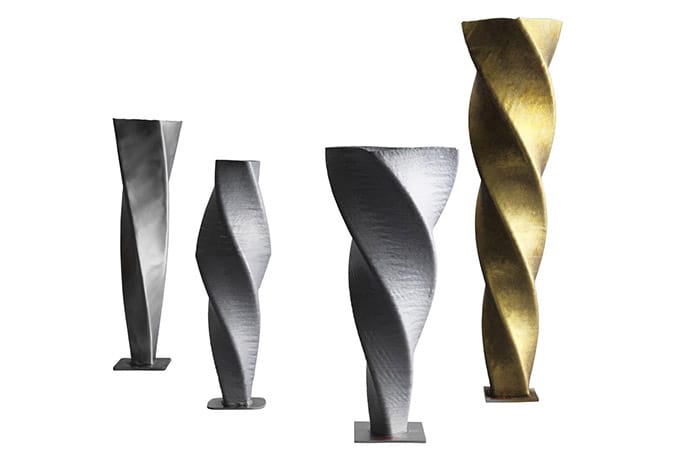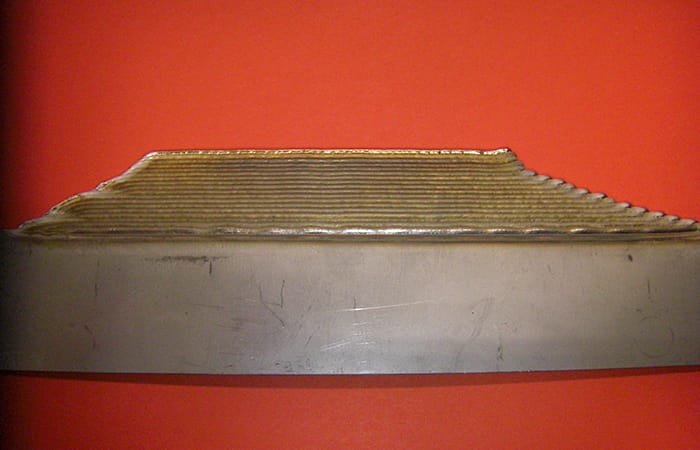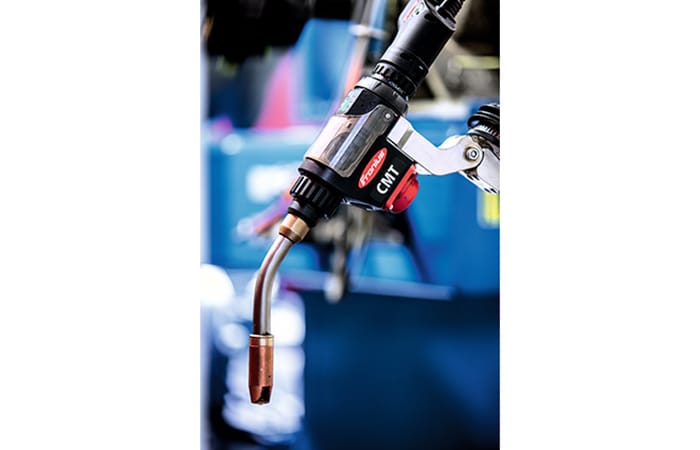Additive production methods generate components by building up material layer by layer. The most well-known example of an additive method is 3D printing. WAAM, which is based on the arc welding process, also produces metal parts layer by layer, with the layers formed by the melting wire electrode. This generative method is particularly advantageous when complex component geometries have to be produced, as the design options are virtually limitless. In addition, parts can be manufactured at low cost and extremely quickly – which makes WAAM a very attractive option for prototype construction and/or small production batches. Processing time, tool wear, and material loss during machining – especially with the conventional approach of milling out the workpiece from a solid block – all mean significant extra costs.
What is WAAM?
There are a number of generative production methods for metal. Essentially these can be divided into two fundamental types: powder-based processes and wire-based processes. In powder-based processes, the layers are built up using molten metal powder. The most common method, the powder bed process, produces extremely precise results, but is somewhat slow in production. Wire-based processes, on the other hand, build up the component by melting a wire-shaped filler metal, requiring the use of a laser, electron beam, or arc. These processes have a high deposition rate and therefore help to cut production times.

Different filler metals can be used for WAAM, such as steel, aluminum, chrome-nickel steel, or bronze.
Wire arc additive manufacturing is a wire-based process, and uses the gas metal arc welding process (GMAW). WAAM itself offers a number of advantages besides its high deposition rate (up to four kilograms per hour with steel materials). In the future, multi-wire solutions could give rise to even higher deposition rates. Equipment and material costs are also important criteria, which is another strength of WAAM: all you need is a suitable welding system. There is no requirement for costly special equipment, such as the vacuum chambers needed for the faster electron beam process.
In comparison to powder-based processes, WAAM benefits from the immediate availability of a range of certified wire types. There are relatively few powder-based materials to choose from, as it can take years to acquire the necessary certification and to produce data sheets, since the use of metal powder is a relatively new technology.
"Cold" Welding Process for Strong Layers
A stable welding process and effective heat dissipation are essential for WAAM. The welding process needs to be sufficiently low energy such that when a new layer is applied, the existing layers do not melt again. In other words, the process needs to be as "cold" as possible. Furthermore, the weld layers need to be continuous, spatter-free, and consistent. If any flaws were to occur, these would be replicated in each subsequent layer.

With wire arc additive manufacturing, components are "welded up" layer by layer before being mechanically reworked. In the example here, a component is being produced from titanium.
The CMT GMAW process from Fronius and its process control variants meet these requirements. They produce a stable arc and a controlled short circuit with long short circuit times. This means that the heat input is lower and the material transfer is practically spatter-free, which helps to prevent flaws.
Two process control variants of CMT are particularly well suited to WAAM. One is the CMT additive process characteristic, which has been optimized for WAAM. It achieves high deposition rates while transferring very little heat into the component. The CMT Cycle Step variant reduces the arc power even further through the controlled deactivation of the arc during the process phase. However, this particularly "cold" process does need longer to build up the layers, as the deposition rate is lower.

Milling thin fan impellers from nickel-based alloys for the electronics industry is an expensive business, while casting is rarely an option. WAAM is an economical alternative.
Real World WAAM Applications
Countless WAAM components have already been produced using welding technology from Fronius in a variety of sectors. These include fan impellers for the electronics industry, which are made from high-grade materials. Milling the workpiece is very expensive due to the high rate of material consumption, while casting is not always able to meet the critical metallurgical properties required for walls just 1.5 mm thick. With WAAM based on CMT Cycle Step, these fan impeller blades can be produced from a nickel-based alloy using an additive approach. It is even possible to repair components using WAAM.

The key factors determining the quality of a component produced using WAAM are the stability of the welding process and low heat input – the Cold Metal Transfer GMAW process from Fronius fulfills these requirements.
Fronius has also implemented another application with a partner in the aviation sector. Titanium is a frequently used material in aircraft construction thanks to its tensile strength, resilience, corrosion resistance, and low weight. The majority of the components are manufactured using subtractive methods, whereby up to 90 percent of the material is milled away. This causes high costs, long machining times, and costly tool wear. Components produced using WAAM, on the other hand, only need reworking to produce a smooth surface. The titanium components produced using the CMT additive process do not exhibit any problems with lack of fusion and have impressive metallurgical properties. Tool costs, machining times, and wear can be reduced, meaning that overall machining costs can be brought down.

The reversible wire electrode used in the CMT welding process mechanically supports droplet detachment. This means that less energy is needed and long short circuit times are achieved – for a "cold" welding process.
WAAM: Economical and Flexible
This makes WAAM a cost-effective and flexible alternative for component production. The additive process can be adopted with relative ease using welding technology from Fronius and the CMT solution.
Contact details:
Fronius UK Ltd
+44 1908 512300
Business Unit Perfect Welding
Fronius Perfect Welding is the innovation leader for arc and resistance spot welding and is the global market leader for robot assisted welding. As system providers, Fronius Welding Automation also turns customer-specific automated complete welding solutions into reality in a number of areas, from container construction right up to cladding for the offshore sector. Power sources for manual applications, welding accessories and a wide range of services add to our portfolio. With more than 1,000 sales partners worldwide, Fronius Perfect Welding is never far away from our customers.
Fronius International GmbH
Fronius International GmbH is an Austrian company with headquarters in Pettenbach and other sites in Wels, Thalheim, Steinhaus and Sattledt. With 4,760 employees worldwide, the company is active in the fields of welding technology, photovoltaics and battery charging technology. 92% of its products are exported through 30 international Fronius subsidiaries and sales partners/representatives in over 60 countries. With its innovative products and services and 1,253 granted patents, Fronius is the global innovation leader.











Water Sector Talent Exodus Could Cripple The Sector
Maybe if things are essential for the running of a country and we want to pay a fair price we should be running these utilities on a not for profit...